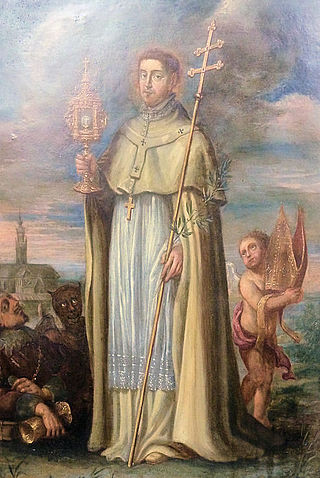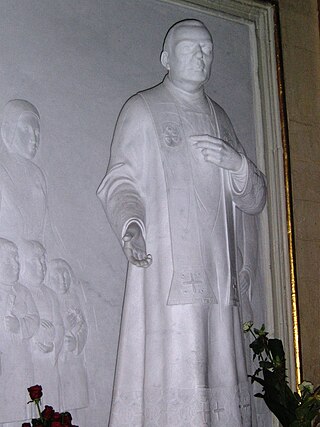Related Research Articles

Norbert of Xanten, O. Praem (Xanten-Magdeburg), also known as Norbert Gennep, was a bishop of the Catholic Church, founder of the Premonstratensian order of canons regular, and is venerated as a saint. Norbert was canonized by Pope Gregory XIII in the year 1582, and his statue appears above the Piazza colonnade of St. Peter's Square in Rome.

The Order of Canons Regular of Prémontré, also known as the Premonstratensians, the Norbertines and, in Britain and Ireland, as the White Canons, is a religious order of canons regular of the Catholic Church founded in Prémontré near Laon in 1120 by Norbert of Xanten, who later became Archbishop of Magdeburg. Premonstratensians are designated by OPraem following their name.

Józef Bilczewski was a Polish Roman Catholic prelate who served as the Archbishop of Lviv from 1900 until his death. He served as a theological and dogmatics professor in the Lviv college after himself having earned two doctorates in the course of his own studies. He earned a reputation as a learned and cultured man; these qualities led to Emperor Franz Joseph I nominating him for the Lviv archdiocese as its head. Pope Leo XIII named him as its archbishop and he set to work prioritizing a range of different pastoral initiatives aimed at revitalizing the faith within people and also prioritizing ecumenical cooperation with other denominations.

Filippo Smaldone was an Italian Roman Catholic priest and the founder of the Salesian Sisters of the Sacred Hearts. Smaldone is best known for his extensive work with the deaf during his lifetime. Smaldone was a gifted preacher known for his commitment to proper catechesis and to the care of orphans and the mute, which earned him civic recognition.

Zygmunt Gorazdowski was a Polish Roman Catholic priest and the founder of the Sisters of Saint Joseph. Gorazdowski suffered from tuberculosis during his childhood which impeded his studies for the priesthood in what required him to take time off in order to recover before he could be ordained. Once he was ordained he served in various parishes while setting up homes for orphans and single mothers as well as hospices and other establishments for a range of people; he was a prolific writer of catechism and other religious notes for the benefit of his flock.
Francesco Spoto was an Italian Catholic priest who served in the missions in the Democratic Republic of Congo and was killed there. He was also a professed member from the Missionary Servants of the Poor.

José Olallo Valdés, OH was a Cuban professed religious and a professed member from the Brothers Hospitallers of Saint John of God. Olallo was dubbed as the "Poor People's Priest" even though Olallo was not an ordained priest - he was even encouraged to become one but refused. Olallo served as a nurse for his entire life and dedicated himself to the care of the ill and the poor and remained a pivotal figure in the hospital that he worked at.

Stanisław Kazimierczyk was a Polish Catholic priest and a professed member of the Canons Regular of the Lateran. He became noted for his ardent devotions to both the Eucharist and to his personal patron saint, Stanislaus of Szczepanów, as well as for his charitable dedication to the ill and poor of Kraków.

Louis Brisson, OSFS was a French Roman Catholic priest and the founder of both the Oblate Sisters of St. Francis de Sales and the Oblates of St. Francis de Sales. He founded the female branch alongside Léonie Aviat and the male branch alongside the Servant of God Thérèse Chappuis. Brisson's founding of the congregations stemmed from his desire to improve the working conditions of middle-class girls and to ensure their protection and the promotion of their faith.

Gerhard Hirschfelder was a German Roman Catholic priest. He was a vocal critic of Nazism and used his sermons to condemn Nazi propaganda and other aspects of Nazism which drew suspicion on him from the authorities who monitored him and even interrogated him on occasion. He was a staunch supporter of the role of adolescents in the life of the Church and made them a focus in his pastoral activities. In his imprisonment he became a member of the Schoenstatt Movement.

Luigi Novarese was an Italian Roman Catholic priest and the co-founder of the Apostolate of the Suffering as well as the Silent Workers of the Cross. Novarese also established the Marian Priest League and the Brothers and Sisters of the Sick; he built several homes for those who were ill and disabled. He served in the Secretariat of State until leaving that position to work alongside the Italian Episcopal Conference and to dedicate more time to the ill and to the work of his orders.

Odoardo Focherini was an Italian Roman Catholic journalist. He issued false documents to Jews during World War II in order for them to escape the Nazi regime but was arrested and sent to a concentration camp where he later died. Yad Vashem later recognized him as a Righteous Among the Nations in 1969 for his efforts.
Luca Passi was an Italian priest and the founder of the Teaching Sisters of Saint Dorothy. Two brothers of his were priests – following the example of their paternal uncle – and Passi himself moved to Venice in order to dedicate himself to both his preaching and educational missions.

Cristóbal of Saint Catherine – born Cristóbal López de Valladolid Orea – was a Roman Catholic Spanish priest and a professed member of the Third Order of Saint Francis. He was the founder of the Franciscan Hospitallers of Jesus of Nazareth which paid careful attention to both religious and social needs of the faithful.

Blessed Luigi Monza was an Italian Roman Catholic priest and the founder of the Secular Institute of the Little Apostles of Charity. Monza's pastoral mission was defined with catering to the needs of the poor and the sick and used his new congregation as a means of spreading this mission.
Khalīl al-Haddād - in religious Ya'Qūb from Ghazīr - was a Lebanese Roman Catholic priest and a professed member of the Order of Friars Minor as a Capuchin friar. He was the founder of the Franciscan Sisters of the Cross. He was a noted preacher and founder of various orphanages and schools across Lebanon. Presidents of the state honored him with various awards while the populace compared him to the likes of Saint Vincent de Paul and Saint Giovanni Bosco.

The Martyrs of Laos are seventeen Catholic priests and professed religious as well as one lay young man venerated as martyrs killed in Laos between 1954 and 1970 of the First and Second Indochina Wars during a period of anti-religious sentiment under the Pathet Lao Theravada Buddhist-communist political movement.

Jean-Baptiste Fouque was a French Roman Catholic priest. He tended to the poor during his time as a parish priest in Marseilles and was noted for his desire to create a large and free hospital for them. He achieved this in 1921 and tended to the old and infirm in the hospital. Fouque also was known for his ministering to displaced peoples during World War I and for his commitment to evangelization.
Luis Navarro was a Guatemalan missionary dedicated to catechesis and evangelization among the local people in Guatemala. He was member of the Secular Franciscan Order. His beatification received approval from Pope Francis and was celebrated in Izabal, Guatemala on 27 October 2018.

Bedřich Bachstein and his thirteen companions were a collective group of Catholic priests and professed religious in the Order of Friars Minor murdered by a group of Protestants in the early 17th century.
References
- 1 2 3 4 "Blessed Pierre-Adrien Toulorge". Santi e Beati. Retrieved 27 July 2016.
- 1 2 3 4 5 6 "Peter-Adrian Toulorge" (PDF). Postulatio. Retrieved 27 July 2016.
- 1 2 3 4 5 6 7 8 9 10 11 "The Life and Martyrdom of Pierre-Adrien Toulorge o.praem". Norbertine Vocations. 26 March 2012. Retrieved 27 July 2016.